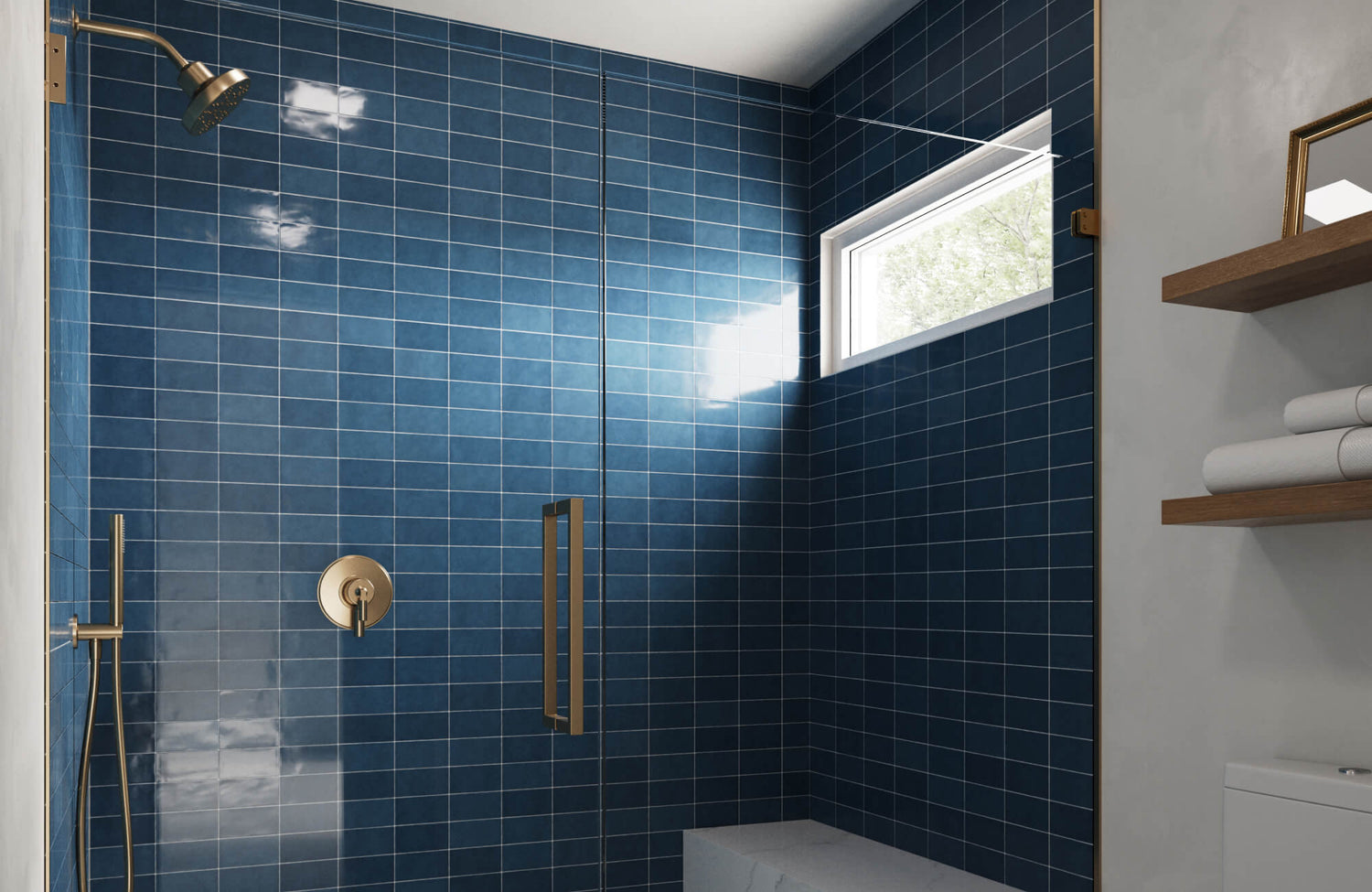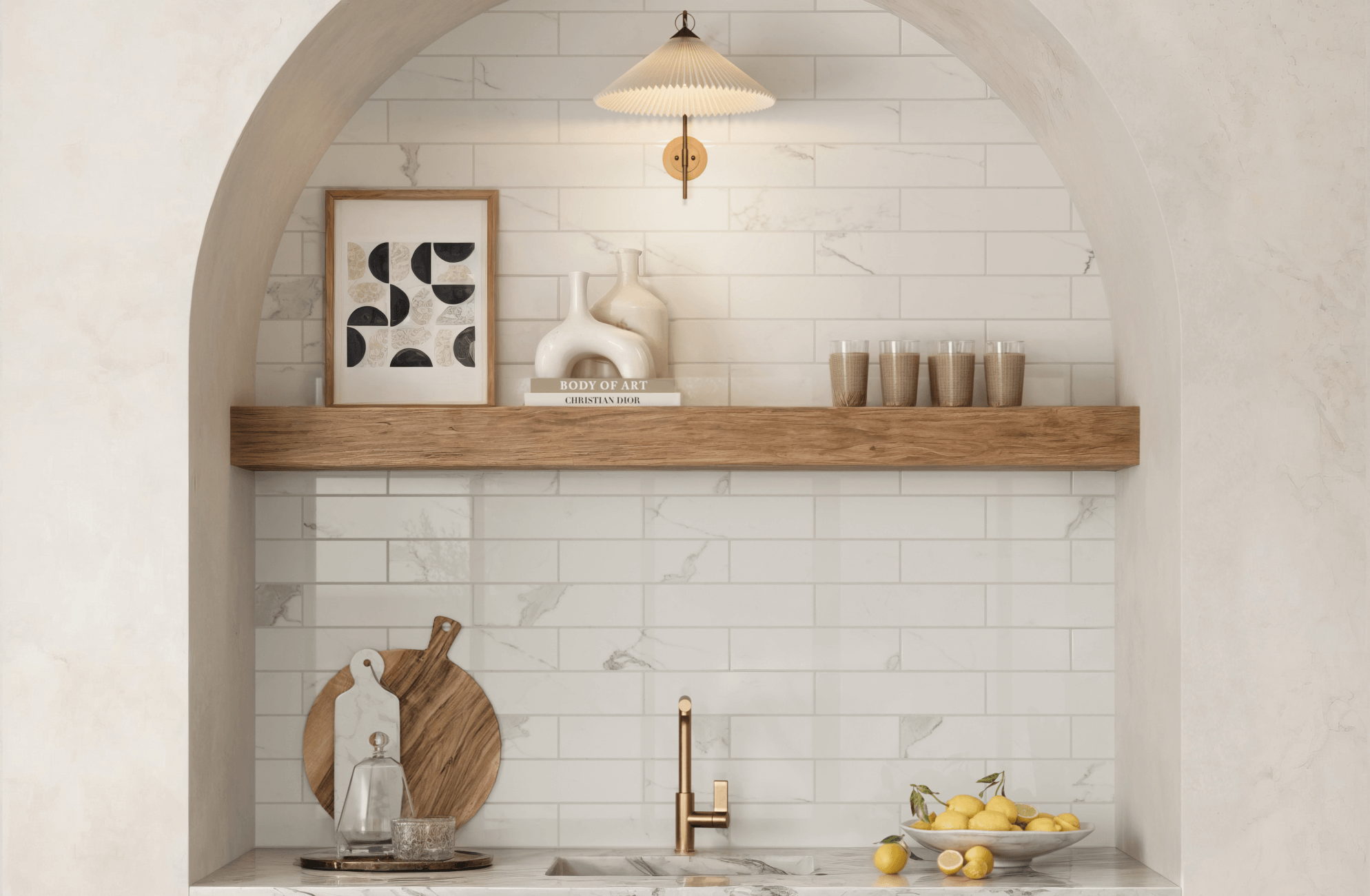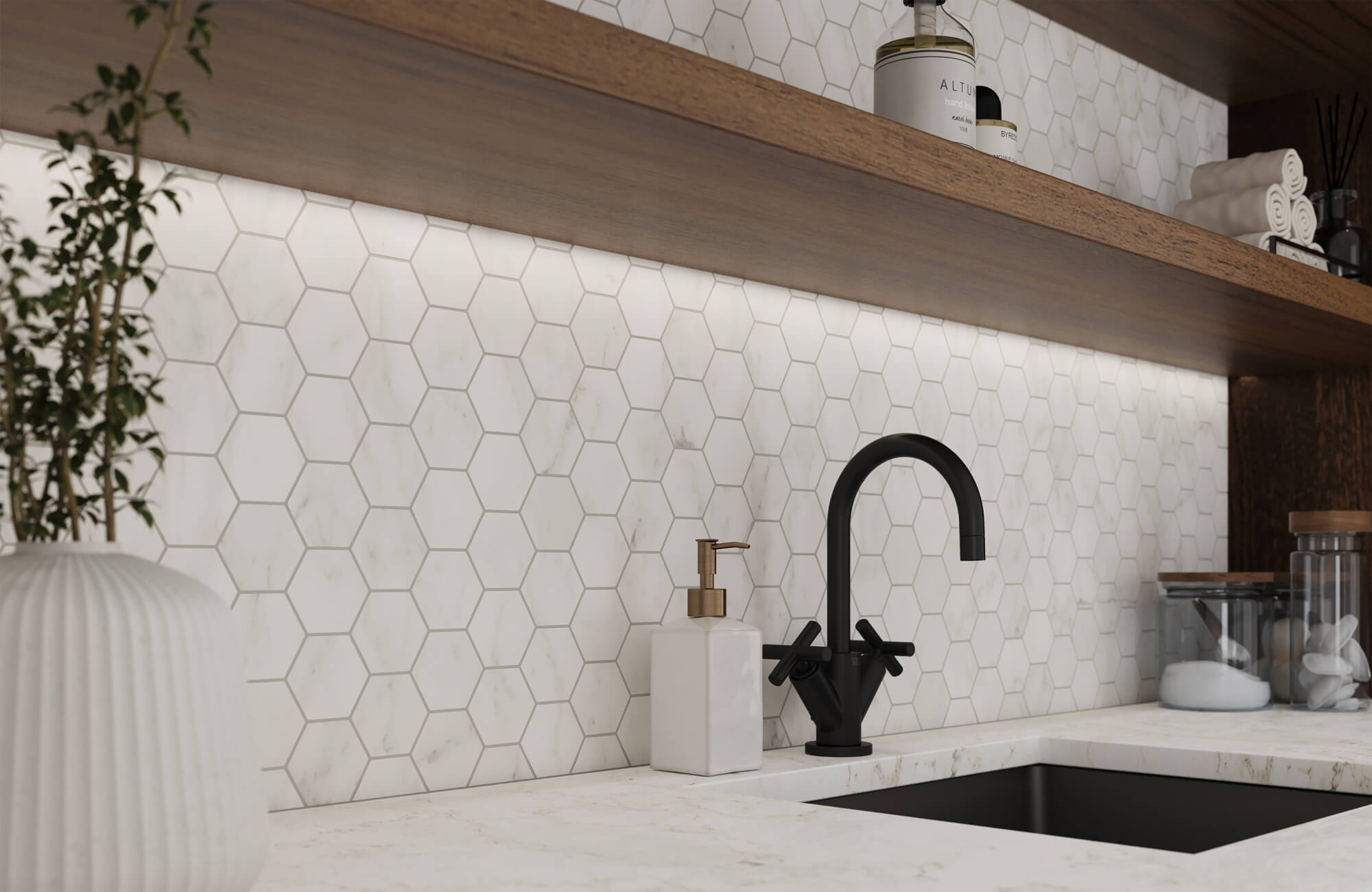Transforming your bathroom into a serene sanctuary isn't just about aesthetics; it's also about practicality. The choice of bathroom tile is paramount, as it significantly impacts the room's overall appearance and the ease of cleaning. Beyond style, the tile's material, finish, and color play a pivotal role in its susceptibility to dirt and grime.
Ceramic, porcelain, and natural stone are common tile materials with unique characteristics and cleaning requirements. The tile's finish, whether glossy, matte, or textured, also affects its cleanliness. Understanding these factors empowers you to make informed decisions and choose tiles that not only enhance your bathroom's design but also minimize your cleaning efforts, ensuring a serene and low-maintenance space.

Selecting the Best Tile Material for Your Bathroom
With a myriad of options available, it's essential to consider factors in choosing the right tile material. Here are the top bathroom tile materials and their unique characteristics to help you make an informed decision.
Ceramic Tile
Ceramic tile, a timeless classic, offers a versatile and affordable option for bathroom walls and, occasionally, floors. Its durability, coupled with a wide range of colors, patterns, and finishes, makes it a popular choice among homeowners. Modern variations with glazed coatings also have non-porous surfaces that make them resistant to stains and water damage. However, because ceramic tile can chip more easily when used on floors, it is generally better suited for wall applications.
Porcelain Tile
Porcelain tile, a denser and more durable version of ceramic tile, is an excellent choice for frequently used areas like bathrooms. Its low porosity and relatively higher resistance to water absorption make it ideal for wet environments. Porcelain tile is also available in a wide range of styles, from sleek and modern to rustic and traditional.
Natural Stone Tile
Natural stone tiles, such as marble, granite, and slate, add a touch of luxury and elegance to any bathroom. Their unique patterns and colors can also create a stunning focal point. However, natural stone requires more care and maintenance than ceramic or porcelain tile.

The Impact of Tile Finish on Cleanliness
The finish of your bathroom tile significantly influences its appearance and ease of maintenance. Below, we’ve outlined the pros and cons of different tile finishes and tips for keeping your tiles looking their best. Remember that to ensure long-lasting beauty and durability, it’s always best to follow the manufacturer’s recommendations for cleaning and maintenance.
Glossy vs. Matte
Glossy bathroom tiles, like the Sarina 3x12 Glossy Ceramic Fishscale Tile in Cloud as shown in the photo above, reflect light beautifully, creating a sleek and modern look. However, their smooth surface may sometimes show water spots and fingerprints. In contrast, matte bathroom tiles offer a more subdued and elegant appearance, although their textured surface can be more prone to trapping dirt and grime.
For those crafted from ceramic or porcelain, you can keep your glossy bathroom tiles sparkling by regular cleaning with a mild detergent and warm water. For tougher stains, a non-abrasive cleaner can also be used. Matte bathroom tiles, on the other hand, may require more frequent cleaning. A soft brush or microfiber cloth can help remove dirt and grime from their surface.
The Role of Color in Cleaning Tiles
The color of your bathroom tiles can also impact their overall appearance and ease of cleaning. Light-colored bathroom tiles can help brighten up a space, but they can also show dirt and grime more easily. Darker bathroom tiles, like the Mikayla 5x5 Glossy Ceramic Tile in Olive, can effectively hide imperfections, though they may require more frequent cleaning to maintain their polished appearance.
When choosing a tile color, consider the overall aesthetic of your bathroom and your personal preferences. If you prefer a clean and minimalist look, light-colored bathroom tiles may be the best option. If you want to create a dramatic and sophisticated space, dark-colored bathroom tiles can be a great choice. For a clearer vision, use Edward Martin’s AR tool to visualize how various colors and tones will look in your space before making a decision. This interactive tool provides a realistic preview, allowing you to make confident choices.

Tips for Easy-to-Clean Grout
Grout, while often overlooked, plays a significant role in the overall appearance and maintenance of your tile installation. Here are some tips for selecting and maintaining grout to ensure a long-lasting and easy-to-clean bathroom.
Grout Material Matters
Grout, the material used to fill the gaps between tiles, plays a crucial role in the overall appearance and durability of your tile installation. Two primary types of grout are commonly used: cement-based and epoxy-based.
Cement-based grout is a more traditional option that is relatively affordable. However, it is porous and can be susceptible to staining and mildew. Epoxy-based grout, on the other hand, is denser and more resistant to water and stains. While it is more expensive than cement-based grout, it can be a worthwhile investment for frequently used, wet environments like bathrooms.
Grout Color and Cleanliness
The color of your grout can significantly impact the overall appearance of your tile installation. Light-colored grout can help to brighten up your bathroom, but it can also show dirt and grime more easily. Dark-colored grout, on the other hand, can hide imperfections but may require more frequent cleaning to maintain its appearance.
When choosing a grout color, it's important to consider the color of your bathroom tiles. A contrasting color can add visual interest, while a matching color can create a seamless and uniform look.
Grout Sealing Essentials for Stronger, Stain-Free Bathroom Tiles
Sealing your grout is essential to protect it from water, stains, and mildew. Grout sealer penetrates the pores of the grout, creating a barrier that repels water and dirt. By sealing your grout, you can help to prolong its life and make it easier to clean.
To seal your grout, you will need a grout sealer and a grout brush. Apply the sealer according to the manufacturer's instructions, making sure to cover all of the grout lines. Afterwards, allow the sealer to dry completely before applying a second coat, if necessary. Regular resealing, typically every one to two years, is recommended to maintain the effectiveness of the sealant.

Cleaning Methods for Bathroom Tiles
Keeping your bathroom tiles sparkling clean is essential for maintaining a hygienic and visually appealing space. Whether you're dealing with ceramic, porcelain, or natural stone, using the right techniques is key to preserving each material's unique qualities. For the best results, it’s always advisable to follow the manufacturer’s recommendations, as this ensures that your cleaning routine is both safe and effective.
Everyday Cleaning Routine
A consistent, daily cleaning routine is the cornerstone of maintaining pristine bathroom tiles. For those made of ceramic or porcelain, a simple solution of warm water and mild detergent is often sufficient to remove dirt and grime. You may also use a soft cloth or sponge to gently scrub the tiles, paying close attention to grout lines. For a more thorough clean, consider using a microfiber cloth, as it can trap dirt and moisture effectively.
Deep Cleaning Your Bathroom Tiles
While daily cleaning is essential, periodic deep cleaning is necessary to remove stubborn stains, mineral deposits, and soap scum. For ceramic and porcelain bathroom tiles, start by applying a commercial tile cleaner to the affected areas, allowing them to sit for a few minutes, then scrub them with a stiff-bristled brush to loosen the grime. Though these tiles are durable, it's important to avoid harsh chemicals that could damage their surface. Also regularly clean grout lines with a grout brush and grout cleaner to keep them fresh.
Natural stone bathroom tiles, on one hand, require special care depending on the type of stone to maintain their beauty. Marble, for instance, is sensitive to acidic substances and can be easily etched, so it's important to use pH-neutral cleaners and avoid harsh chemicals. Granite, in contrast, is more durable and resistant to stains, while slate, a naturally cleft stone, can be slippery when wet. To increase traction, non-slip treatments can be applied. It's also important to seal natural stone tiles periodically to protect them from stains and water damage.
Preventing Mold and Mildew
Mold and mildew thrive in damp, humid environments, making bathrooms a prime breeding ground. To prevent these unsightly and harmful organisms, it's crucial to maintain proper ventilation. Ensure that your bathroom exhaust fan is working efficiently and use it whenever showering or bathing. Additionally, keep the area dry by using a squeegee to remove excess water from the shower walls and tiles after each use. For natural stones, pay extra attention to drying surfaces, especially on slate, where water may collect in the textured surface, potentially leading to mold buildup.
Natural Cleaning Solutions
For those who prefer eco-friendly cleaning solutions, there are several natural alternatives that can effectively clean bathroom tiles. White vinegar, for instance, is a powerful natural disinfectant that can kill bacteria and remove mineral deposits. A mixture of equal parts white vinegar and water can be applied to tiles and grout, left to sit for a few minutes, and then rinsed clean. However, as previously highlighted, avoid using vinegar on marble, granite, or other natural stones, as its acidity can damage the surface. A safer natural cleaner for stone surfaces is a gentle baking soda and water mixture, which can remove stains without etching or scratching. Another effective natural cleaner is lemon juice, which can help brighten ceramic and porcelain tiles and remove stubborn stains but should also be avoided on sensitive stones like marble.
Maintaining Your Bathroom Tiles for a Lasting, Low-Maintenance Finish
Choosing the right bathroom tile is a crucial decision that can significantly impact the overall look, feel, and maintenance of your space, especially if factors like material, finish, and color are taken into account. For ease of cleaning, ceramic and porcelain bathroom tiles with a glossy finish are the best choices, as they require less maintenance compared to their natural stone counterparts. If you’re interested in these options, you can request tile samples from Edward Martin to see their colors and finishes firsthand. For a more personalized approach, consulting with a design professional can also help you choose the ideal tile to achieve your desired bathroom style.
Remember that regular cleaning is essential to maintain their beauty and hygiene. A simple daily cleaning routine with mild detergent and warm water can prevent dirt and grime buildup. Periodic deep cleaning is also necessary to remove stubborn stains and mineral deposits. Additionally, sealing your grout can help protect it from water and stains. By following these tips, you can enjoy a beautiful and functional bathroom that requires minimal maintenance.







